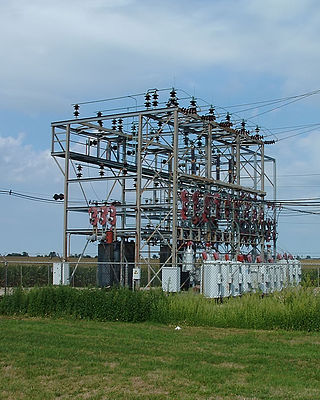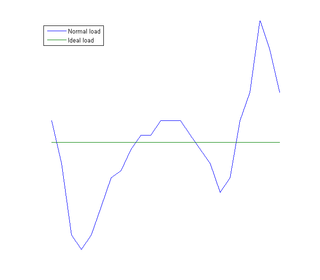Related Research Articles

Power-line communication (PLC) is the carrying of data on a conductor that is also used simultaneously for AC electric power transmission or electric power distribution to consumers. The line that does so is known as a power-line carrier.

Distributed generation, also distributed energy, on-site generation (OSG), or district/decentralized energy, is electrical generation and storage performed by a variety of small, grid-connected or distribution system-connected devices referred to as distributed energy resources (DER).

The utility frequency, (power) line frequency or mains frequency is the nominal frequency of the oscillations of alternating current (AC) in a wide area synchronous grid transmitted from a power station to the end-user. In large parts of the world this is 50 Hz, although in the Americas and parts of Asia it is typically 60 Hz. Current usage by country or region is given in the list of mains electricity by country.
Energy demand management, also known as demand-side management (DSM) or demand-side response (DSR), is the modification of consumer demand for energy through various methods such as financial incentives and behavioral change through education.

Vehicle-to-grid (V2G) describes a system in which plug-in electric vehicles (PEVs) sell demand response services to the grid. Demand services are either delivering electricity to the grid or reducing the rate of charge from the grid. Demand services reduce the peaks in demand for grid supply, and hence reduce the probability of disruption from load variations. Vehicle-to-load (V2L) and Vehicle-to-vehicle (V2V) are related, but the AC phase is not synchronised with the grid, so the power is only available to "off-grid" load.
This is an alphabetical list of articles pertaining specifically to electrical and electronics engineering. For a thematic list, please see List of electrical engineering topics. For a broad overview of engineering, see List of engineering topics. For biographies, see List of engineers.

Demand response is a change in the power consumption of an electric utility customer to better match the demand for power with the supply. Until the 21st century decrease in the cost of pumped storage and batteries, electric energy could not be easily stored, so utilities have traditionally matched demand and supply by throttling the production rate of their power plants, taking generating units on or off line, or importing power from other utilities. There are limits to what can be achieved on the supply side, because some generating units can take a long time to come up to full power, some units may be very expensive to operate, and demand can at times be greater than the capacity of all the available power plants put together. Demand response, a type of energy demand management, seeks to adjust in real-time the demand for power instead of adjusting the supply.
A microgrid is a local electrical grid with defined electrical boundaries, acting as a single and controllable entity. It is able to operate in grid-connected and in island mode. A 'stand-alone microgrid' or 'isolated microgrid' only operates off-the-grid and cannot be connected to a wider electric power system. Very small microgrids are called nanogrids.
Dynamic Demand is the name of a semi-passive technology to support demand response by adjusting the load demand on an electrical power grid. It is also the name of an independent not-for-profit organization in the UK supported by a charitable grant from the Esmée Fairbairn Foundation, dedicated to promoting this technology. The concept is that by monitoring the frequency of the power grid, as well as their own controls, intermittent domestic and industrial loads switch themselves on/off at optimal moments to balance the overall grid load with generation, reducing critical power mismatches. As this switching would only advance or delay the appliance operating cycle by a few seconds, it would be unnoticeable to the end user. This is the foundation of dynamic demand control. In the United States, in 1982, a (now-lapsed) patent for this idea was issued to power systems engineer Fred Schweppe. Other patents have been issued based on this idea.

A phasor measurement unit (PMU) is a device used to estimate the magnitude and phase angle of an electrical phasor quantity in the electricity grid using a common time source for synchronization. Time synchronization is usually provided by GPS or IEEE 1588 Precision Time Protocol, which allows synchronized real-time measurements of multiple remote points on the grid. PMUs are capable of capturing samples from a waveform in quick succession and reconstructing the phasor quantity, made up of an angle measurement and a magnitude measurement. The resulting measurement is known as a synchrophasor. These time synchronized measurements are important because if the grid’s supply and demand are not perfectly matched, frequency imbalances can cause stress on the grid, which is a potential cause for power outages.

Load balancing, load matching, or daily peak demand reserve refers to the use of various techniques by electrical power stations to store excess electrical power during low demand periods for release as demand rises. The aim is for the power supply system to have a load factor of 1.

Load management, also known as demand-side management (DSM), is the process of balancing the supply of electricity on the network with the electrical load by adjusting or controlling the load rather than the power station output. This can be achieved by direct intervention of the utility in real time, by the use of frequency sensitive relays triggering the circuit breakers, by time clocks, or by using special tariffs to influence consumer behavior. Load management allows utilities to reduce demand for electricity during peak usage times, which can, in turn, reduce costs by eliminating the need for peaking power plants. In addition, some peaking power plants can take more than an hour to bring on-line which makes load management even more critical should a plant go off-line unexpectedly for example. Load management can also help reduce harmful emissions, since peaking plants or backup generators are often dirtier and less efficient than base load power plants. New load-management technologies are constantly under development — both by private industry and public entities.

The smart grid is an enhancement of the 20th century electrical grid, using two-way communications and distributed so-called intelligent devices. Two-way flows of electricity and information could improve the delivery network. Research is mainly focused on three systems of a smart grid – the infrastructure system, the management system, and the protection system. Electronic power conditioning and control of the production and distribution of electricity are important aspects of the smart grid.

An electric power system is a network of electrical components deployed to supply, transfer, and use electric power. An example of a power system is the electrical grid that provides power to homes and industries within an extended area. The electrical grid can be broadly divided into the generators that supply the power, the transmission system that carries the power from the generating centers to the load centers, and the distribution system that feeds the power to nearby homes and industries.

An electrical grid is an interconnected network for electricity delivery from producers to consumers. Electrical grids consist of power stations, electrical substations to step voltage up or down, electric power transmission to carry power over long distances, and finally electric power distribution to customers. In that last step, voltage is stepped down again to the required service voltage. Power stations are typically built close to energy sources and far from densely populated areas. Electrical grids vary in size and can cover whole countries or continents. From small to large there are microgrids, wide area synchronous grids, and super grids. The combined transmission and distribution network is part of electricity delivery, known as the power grid.
Ancillary services are the services necessary to support the transmission of electric power from generators to consumers given the obligations of control areas and transmission utilities within those control areas to maintain reliable operations of the interconnected transmission system.
Smart grid policy in the United States refers to legislation and other governmental orders influencing the development of smart grids in the United States.
GridLAB-D is an open-source simulation and analysis tool that models emerging smart grid energy technologies. It couples power flow calculations with distribution automation models, building energy use and appliance demand models, and market models. It is used primarily to estimate the benefits and impacts of smart grid technology.
The UCLA Smart Grid Energy Research Center (SMERC), located on the University of California Los Angeles (UCLA) campus, is an organization focused on developing the next generation of technologies and innovation for Smart Grid. SMERC partners with government agencies, technology providers, Department of Energy (DOE) research labs, universities, utilities, policymakers, electric vehicle manufacturers, and appliance manufacturers. These partnerships provide SMERC with diverse capabilities and exceptional, mature leadership.
Transactive energy refers to the economic and control techniques used to manage the flow or exchange of energy within an existing electric power system in regards to economic and market based standard values of energy. It is a concept that is used in an effort to improve the efficiency and reliability of the power system, pointing towards a more intelligent and interactive future for the energy industry.
References
- ↑ Ning Lu; Hammerstrom, D.J.; "Design Considerations for Frequency Responsive Grid Friendly Appliances," Transmission and Distribution Conference and Exhibition, 2005/2006 IEEE PES, vol., no., pp.647-652, 21–24 May 2006
- ↑ Ning Lu; Hammerstrom, D.J.; "Design Considerations for Frequency Responsive Grid Friendly Appliances," Transmission and Distribution Conference and Exhibition, 2005/2006 IEEE PES, vol., no., pp.647-652, 21–24 May 2006
- ↑ Ning Lu; Hammerstrom, D.J.; "Design Considerations for Frequency Responsive Grid Friendly Appliances," Transmission and Distribution Conference and Exhibition, 2005/2006 IEEE PES, vol., no., pp.647-652, 21–24 May 2006
- ↑ Voltage Level as Information Carrier in Smart Distribution Networks
- ↑ Chen, Heng. "Cascaded stalling of induction motors in fault-induced delayed voltage recovery (FIDVR)." Univ. Wisconsin-Madison, ECE Depart.(2011).
- ↑ Kundu, Soumya, and Ian A. Hiskens. "Overvoltages due to synchronous tripping of plug-in electric-vehicle chargers following voltage dips." IEEE Transactions on Power Delivery 29.3 (2014): 1147-1156.
- ↑ Quint, R.; Kosterev, D.; Undrill, J.; Eto, J.; Bravo, R.; Wen, J. (July 2016). "Power quality requirements for electric vehicle chargers: Bulk power system perspective". 2016 IEEE Power and Energy Society General Meeting (PESGM). pp. 1–5. doi:10.1109/pesgm.2016.7741443. ISBN 978-1-5090-4168-8. S2CID 25711601.
- ↑ D. Hammerstrom et al. (2007). Pacific Northwest GridWise Testbed Demonstration Projects Part I. Olympic Peninsula Project. PNNL no. 17167, Pacific Northwest National Laboratory, Richland, Washington [ permanent dead link ]
- ↑ D. Hammerstrom et al. (2007). Pacific Northwest GridWise Testbed Demonstration Projects Part II. Grid Friendly Appliance Project. PNNL no. 17079, Pacific Northwest National Laboratory, Richland, Washington [ permanent dead link ]